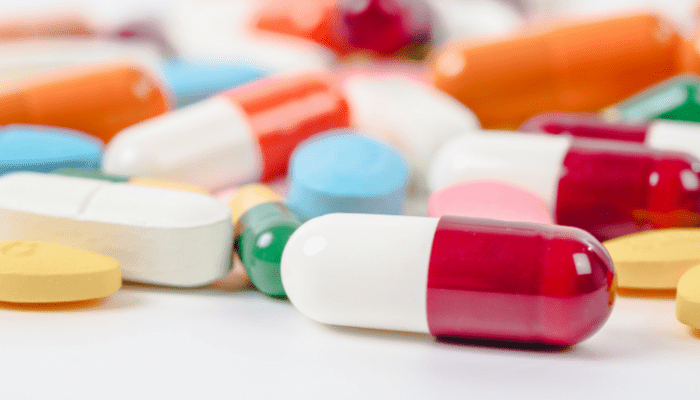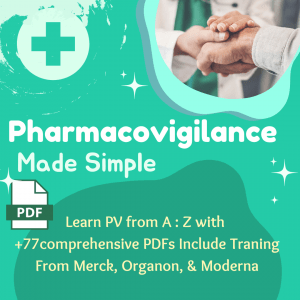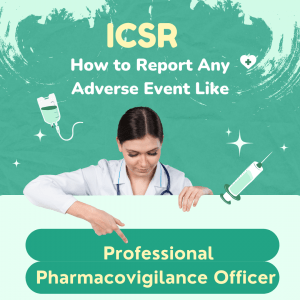Introduction to Pharmacovigilance: How Drug Safety is Enforced By Pharmacovigilance

Introduction to pharmacovigilance is a complex topic that can be difficult to understand.
The role of pharmacovigilance is to ensure the safety and efficacy of drugs by monitoring their effects on patients.
This introduction will provide an overview of what pharmacovigilance means, how it works, how our Pharmacovigilance Online Course and our Pharmacovigilance PDF Materials can help simplify Pharmacovigilance, and why it’s important for drug safety. It also includes short courses about the subject.
The pharmacovigilance Introduction includes its definitions, role, and types of vigilance. How pharmacovigilance works for drug safety.
This blog post will cover the Introduction to pharmacovigilance and how it ensures drug safety.
You will also learn about the different types of vigilance used in pharmacovigilance and how they work together to ensure drug safety while maintaining patient confidentiality.
– Introduction to Pharmacovigilance
– Role of Pharmacovigilance
– Types of Vigilances
– How does pharmacovigilance work?
– How Pharmacovigilance Signal Detection is important.
Pharmacovigilance Foundations Online Courses
What is pharmacovigilance and what does it involve?

Pharmacovigilance is the science and practice of monitoring the effects of drugs on patients. It is a branch of public health that aims to protect patients from the adverse effects of drugs.
Pharmacovigilance involves the collection, analysis, and interpretation of data on the adverse effects of drugs.
It also involves the identification of new safety information and the assessment of the risk-benefit balance of medicines.
The role of pharmacovigilance is to ensure that the benefits of medicines outweigh their risks. By ensuring that the drug safety department follows the pharmacovigilance audit checklist to implement FDA guidance.
It is crucial to collect data on the adverse effects of drugs so that we can identify any potential risks.
The aim is to ensure that patients are given safe and effective medicines.
Pharmacovigilance is monitoring the effects of drugs after they have been marketed. It is a critical component in ensuring the safety of drugs.
The pharmacovigilance process involves collecting, analyzing, and reporting data on adverse drug reactions.
This data is used to identify potential risks associated with the use of drugs.
The role of pharmacovigilance in ensuring drug safety

Pharmacovigilance is the process of monitoring and reporting the adverse effects of drugs. It is an important tool in ensuring the safety and efficacy of medications.
The role of pharmacovigilance is to detect and monitor potential adverse drug reactions.
This helps to protect patients from harm and also helps to ensure the safety and efficacy of medications.
Pharmacovigilance involves 2 key steps:
1. Detection: This step involves detecting any potential adverse drug reactions. This is done by monitoring clinical trials, post-market surveillance, and other data sources.
2. Evaluation: This step involves assessing the potential risks and benefits of the drug. This includes examining the data from the detection step as well as consulting
How pharmacovigilance works to keep drugs safe

Pharmacovigilance monitors the effects of drugs after they have been licensed.
Pharmacovigilance aims to ensure that the benefits of drug therapy continue to outweigh the risks and that patients are using safe and effective medicines.
Pharmacovigilance involves several activities, including:
– Receiving reports of suspected adverse drug reactions (ADRs) from healthcare professionals and patients
– Reviewing case reports to determine whether a drug has caused an ADR
– Investigating potential associations between drugs and adverse events
– publishing safety alerts and other information about suspected risks associated with particular drugs
The role of pharmacovigilance is critical in ensuring that patients receive safe and effective.
Pharmacovigilance training and courses

Pharmacovigilance is the pharmacological science of vigilance against adverse effects or complications arising from the use of drugs.
It is a system used to monitor and identify potential medication problems.
Pharmacovigilance helps ensure that the benefits of medications outweigh the risks and that patients take the safest possible medication.
There are several different ways that pharmacovigilance can be used to keep track of drug safety.
One way is through pharmacovigilance reporting, when healthcare professionals or patients report any problems they have experienced with medications.
This information is collected and analyzed to see if there is a pattern and if the medication needs to be changed or taken off the market.
The future of pharmacovigilance

The role of pharmacovigilance is to ensure that the benefits of medicines outweigh their risks.
It is vital to collect data on the adverse effect of drugs so that we can identify any potential risks.
The aim is to ensure that patients are given safe and effective medicines.
Pharmacovigilance helps to ensure that the benefits of a drug are greater than the risks. By collecting data on the adverse effect of drugs, we can identify any potential risks associated with their use.
This information is used to decide whether a drug should be made available to patients.
It is also used to help healthcare professionals make informed decisions about prescribing a drug.
The Importance of Pharmacovigilance in Protecting the Public

Pharmacovigilance is the process of monitoring and collecting data on the adverse effects of medicines.
It is important to ensure that the general public is aware of any potential risks associated with the use of a particular medicine.
The aim of pharmacovigilance is to protect patients from the potential risks associated with the use of medicines.
How Pharmacovigilance Saves Lives

Pharmacovigilance is the science and practice of monitoring the effects of drugs on humans. It is a critical aspect of ensuring drug safety.
By monitoring the side effects of medications, pharmacovigilance helps to identify potential risks associated with particular drugs.
This information can then be used to make safer medications available to the public.
What are the Various Types of Vigilance in Pharmacovigilance?

What is Passive Surveillance?
Passive surveillance is the process of regularly collecting and evaluating the information on adverse drug reactions (ADRs) from a variety of sources in order to identify, assess and quantify the risks associated with the use of medicinal products.
Passive surveillance is also known as spontaneous reporting.
Passive surveillance is the pharmacovigilance method that relies on healthcare professionals and patients to voluntarily report any adverse drug reactions.
The main advantage of passive surveillance is that it can detect potential safety signals early.
However, the disadvantage is that it may not be able to detect all adverse reactions.
What is Active Surveillance?
Active surveillance is a pharmacovigilance methodology that is used to detect and monitor adverse drug reactions (ADRs) in real-time.
ADRs are any undesired effects associated with the use of a drug. Active surveillance is used in addition to other pharmacovigilance methods, such as spontaneous reporting.
What is Cohort Event Monitoring?
Cohort Event Monitoring (CEM) is a type of pharmacovigilance that is used to detect and monitor adverse drug reactions (ADRs) that occur in groups of people, usually patients who have been taking a drug for a certain period of time.
This type of pharmacovigilance is often used to assess the safety of new drugs, as well as to monitor the safety of drugs that are already on the market.
What is Targeted Clinical Investigation
Clinical trials are conducted in accordance with GCP guidelines, as laid down by ICH, to ensure the quality, integrity, and safety of clinical data.
Clinical trials can be broadly classified into two types – targeted and non-targeted. In targeted clinical trials, patients are selected for treatment on the basis of their genotype or phenotype.
Non-targeted clinical trials do not involve any such selection criterion and all patients who meet the eligibility criteria are enrolled in the study.
What is the concept of pharmacovigilance?
The concept of pharmacovigilance is the process of detecting, assessing, and preventing adverse effects associated with the use of drugs.
Pharmacovigilance plays a critical role in ensuring the safety of drugs and helps to protect patient health. It involves monitoring the worldwide safety of prescription and over-the-counter medications.
What are the four main components of pharmacovigilance?
The four main components of pharmacovigilance are the detection, assessment, understanding, and prevention of adverse drug effects.
Pharmacovigilance is a critical component in ensuring that drugs marketed to the public are safe.
Adverse drug effects can range from mild to severe, and even life-threatening.
By detecting and reporting adverse drug effects, pharmacovigilance helps to protect the public from harm.
What are the principles of pharmacovigilance?
Pharmaceutical vigilance is a term that is used to describe the actions or organizational structures that are put in place to ensure the safety of a drug.
Pharmacovigilance is the term given to the science of drug safety, and it is the branch of pharmacology that is responsible for monitoring the effects of medications both during clinical trials and after they are released onto the market.
One of the primary goals of pharmacovigilance is to identify potential adverse effects associated with medication as early as possible.
This allows for any necessary course corrections to be made before too many people are harmed by the drug.
The adverse effect can range from relatively mild problems such as nausea or headaches to more serious issues such as organ damage or death.
What are the types of pharmacovigilance?
There are different types of pharmacovigilance, which can be broadly divided into spontaneous and stimulated reporting.
Spontaneous reporting is where adverse reactions (ADRs) are reported by healthcare professionals and patients, without any prior contact from the regulatory authorities.
Stimulated reporting is where ADRs are reported to a pharmacovigilance center after being contacted by the regulatory authorities.
What are the tools used in pharmacovigilance?
Pharmacovigilance is case reporting, signal detection, and risk management.
Case reporting is the process of collecting and submitting reports of adverse reactions (ADRs) and other safety information from healthcare professionals and patients.
Signal detection is the process of identifying signals from case reports that may indicate a potential risk associated with a drug.
Risk management is the process of assessing the risks and benefits of a drug to determine whether the benefits outweigh the risks.
The tools used in pharmacovigilance
The tools used in pharmacovigilance are case reporting, signal detection, and risk management.
Case reporting is the process of collecting and submitting reports of adverse drug reactions (ADRs) and other safety information from healthcare professionals and patients.
Signal detection is the process of identifying signals from case reports that may indicate a potential risk associated with a drug.
Risk management is the process of assessing the risks and benefits of a drug to determine whether the benefits outweigh the risks.
One of the most important tools used in pharmacovigilance is the World Health Organization’s Adverse Drug Reaction (WHO-ADR) database.
This database contains reports of adverse drug reactions from all over the world.
It is a valuable resource for pharmacovigilance because it allows pharmacovigilance experts to study the patterns of adverse drug reactions.
Some software used in pharmacovigilance are:
- Oracle Argus Safety
- ArisG
- Oracle Adverse Event Reporting System (AERS)
- ClinTrace
- PvNET
- repClinical
- Vigilanz Dynamic Monitoring System
- WebMD
- PV works
What are drug-related problems with international drug monitoring?
The world health organization is responsible for international drug monitoring.
Other drug-related problems include activities relating to the manufacture, distribution, prescription, and use of psychoactive substances.
These activities include: -preventing the diversion of psychotropic drugs into illegal channels of distribution;
-regulating prescription and dispensing practices;
-controlling the manufacture, import, and export of psychotropic drugs;
-licensing and controlling the cultivation of plants from which psychoactive drugs are obtained. Psychoactive substances are classified into four groups:
-stimulants (e.g. cocaine, amphetamines);
-depressants (e.g. barbiturates, alcohol); –hallucinogens (e.g. LSD, cannabis); and -others (e.g. MDMA, ketamine).
The world health organization aims to provide an international perspective on drug.
-related problems and to increase cooperation between countries to address these problems effectively.
Introduction to pharmacovigilance and Its relation to Healthcare products regulatory agency
Pharmacovigilance is the science and activities related to the detection, assessment, understanding, and prevention of adverse events or any other drug-related problems.
A healthcare product regulatory agency (HPRA) ensures that medicines and medical devices on the market are safe. One of the key ways in which HPRA achieves this is through pharmacovigilance.
Pharmacovigilance plays a vital role in healthcare product regulation as it helps to identify previously unknown safety concerns.
It also allows for a better understanding of the risks and benefits of healthcare products.
HPRA uses this information to make sure that only safe and effective products are available on the market.
If you have any concerns about a healthcare product, you can report them to HPRA through our Pharmacovigilance Section.
Your report will be reviewed by our experts and may help to improve the safety of healthcare products available in Ireland.
How individual case safety reports are the most important task in drug safety departments?
Introduction to Pharmacovigilance is preventing adverse effects or any other medicine-related problem.
A large part of pharmacovigilance is the individual case safety report (ICSR).
ICSRs are necessary reporting for detecting previously unknown adverse drug reactions and play a vital role in keeping patients safe.
Safety data from ICSRs is used to generate alerts about potential safety issues, evaluate the risk-benefit profile of medicines as listed in Pharmacovigilance Master FiIle, and make recommendations on changes to prescribing advice.
They also help to inform regulatory decision-making on matters such as marketing authorization withdrawals and product recalls.
In short, ICSRs are essential for ensuring the safe use of medicines and protecting patients.
The main goal is to keep a risk-benefit balance to ensure patient safety according to Pharmacovigilance PDFs Materials that are written according to FDA guidelines to avoid any future drug safety issues.
What are ethical and societal considerations in Pharmacovigilance?
Ethical considerations in pharmacovigilance are global due to the worldwide distribution of medicines and the global clinical trial results database.
Pharmacovigilance has been defined by international society and international organizations. In clinical research, a prospective study design is usually used to collect data on adverse events.
The retrospective study design is sometimes used in observational epidemiological studies. Case reports can also generate hypotheses but cannot be used to estimate frequency or establish causation.
Pharmacists should be aware of ethical considerations when conducting pharmacovigilance activities.
What is the role of the Uppsala monitoring center in inpatient care?
The Uppsala Monitoring Centre (UMC) is an international organization that plays a crucial role in inpatient care.
The UMC is responsible for monitoring the life cycle of medicines, from development through to use in patients.
This includes keeping track of adverse events and assessing the benefits and risks of medicines. The UMC also provides regulatory agencies with a rapid understanding of new safety signals.
This is vital for ensuring that patients receive the best possible care. In short, the UMC plays a key role in ensuring that medicines are safe and effective.
What are the examples of medication errors reported by pharmaceutical companies?
Pharmaceutical companies are required to report medication errors to the pharmacovigilance system.
Expedited reporting is used for errors that could potentially lead to serious patient harm. The most common type of medicinal product error reported is incorrect dosing.
This can occur when a patient is given the wrong dose of medication or when a healthcare professional prescribes the wrong dose.
Other errors include the wrong route of administration, the wrong time, and the use of incorrect medication.
In some cases, these errors can lead to serious patient harm. Therefore, pharmacists must be aware of the potential for medication errors and take steps to prevent them.
Other Related ArticlesYou Must Read:
49 Top Important Hard Skills For the Resume
Best Pharmacovigilance Online Course
Wrap Up
Introduction to pharmacovigilance is the key principle and the main goal of any regulatory authority and pharmaceutical medicine students to ensure that the pharmacovigilance program is implemented in all areas of the healthcare sector.
-
 Product on salePharmacovigilance PDF MaterialsOriginal price was: 299 $.49 $Current price is: 49 $.
Product on salePharmacovigilance PDF MaterialsOriginal price was: 299 $.49 $Current price is: 49 $. -
 Product on saleICSR Pharmacovigilance | Individual Case Safety Report Online TrainingOriginal price was: 59 $.19 $Current price is: 19 $.
Product on saleICSR Pharmacovigilance | Individual Case Safety Report Online TrainingOriginal price was: 59 $.19 $Current price is: 19 $.
- PV Shop2 products





